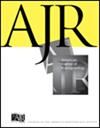Quantitative Ultrasound and Ultrasound-Based Elastography for Chronic Liver Disease: Practical Guidance, From the AJR Special Series on Quantitative Imaging.
IF 4.7
2区 医学
Q1 RADIOLOGY, NUCLEAR MEDICINE & MEDICAL IMAGING
引用次数: 0
Abstract
Quantitative ultrasound (QUS) and ultrasound-based elastography techniques are emerging as non-invasive effective methods for assessing chronic liver disease. They are more accurate than B-mode imaging alone and more accessible than MRI as alternatives to liver biopsy. Early detection and monitoring of diffuse liver processes such as steatosis, inflammation, and fibrosis play an important role in guiding patient management. The most widely available and validated techniques are attenuation-based QUS techniques and shear-wave elastography techniques that measure shear-wave speed. Other techniques are supported by a growing body of evidence and are increasingly commercialized. This review explains general physical concepts of QUS and ultrasound-based elastography techniques for evaluating chronic liver disease. The first section describes QUS techniques relying on attenuation, backscatter, and speed of sound. The second section discusses ultrasound-based elastography techniques analyzing shear-wave speed, shear-wave dispersion, and shear-wave attenuation. With an emphasis on clinical implementation, each technique's diagnostic performance along with thresholds for various clinical applications are summarized, to provide guidance on analysis and reporting for radiologists. Measurement methods, advantages, and limitations are also discussed. The third section explores developments in quantitative contrast-enhanced and vascular ultrasound that are relevant to chronic liver disease evaluation.慢性肝病的定量超声和超声弹性成像:实用指南》,摘自《AJR 定量成像特别系列》。
定量超声(QUS)和超声弹性成像技术正在成为评估慢性肝病的无创有效方法。作为肝活检的替代方法,它们比单纯的 B 型成像更准确,比核磁共振成像更容易获得。早期检测和监测弥漫性肝脏病变,如脂肪变性、炎症和纤维化,在指导患者管理方面发挥着重要作用。目前最广泛使用和经过验证的技术是基于衰减的 QUS 技术和测量剪切波速度的剪切波弹性成像技术。其他技术也有越来越多的证据支持,并日益商业化。本综述解释了用于评估慢性肝病的 QUS 和超声弹性成像技术的一般物理概念。第一部分介绍了基于衰减、反向散射和声速的 QUS 技术。第二部分讨论了分析剪切波速度、剪切波弥散和剪切波衰减的超声弹性成像技术。以临床应用为重点,总结了每种技术的诊断性能以及各种临床应用的阈值,为放射科医生的分析和报告提供指导。此外,还讨论了测量方法、优势和局限性。第三部分探讨了与慢性肝病评估相关的定量对比增强和血管超声的发展。
本文章由计算机程序翻译,如有差异,请以英文原文为准。
求助全文
约1分钟内获得全文
求助全文
来源期刊
CiteScore
12.80
自引率
4.00%
发文量
920
审稿时长
3 months
期刊介绍:
Founded in 1907, the monthly American Journal of Roentgenology (AJR) is the world’s longest continuously published general radiology journal. AJR is recognized as among the specialty’s leading peer-reviewed journals and has a worldwide circulation of close to 25,000. The journal publishes clinically-oriented articles across all radiology subspecialties, seeking relevance to radiologists’ daily practice. The journal publishes hundreds of articles annually with a diverse range of formats, including original research, reviews, clinical perspectives, editorials, and other short reports. The journal engages its audience through a spectrum of social media and digital communication activities.
文献相关原料
| 公司名称 | 产品信息 | 采购帮参考价格 |
|---|

 求助内容:
求助内容: 应助结果提醒方式:
应助结果提醒方式:


